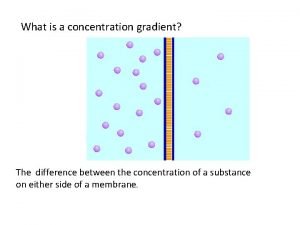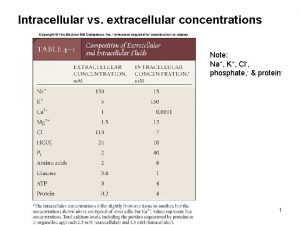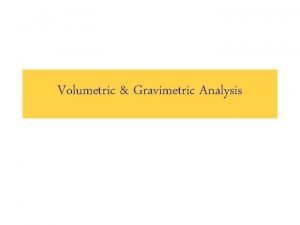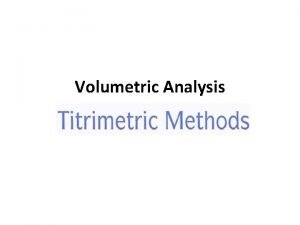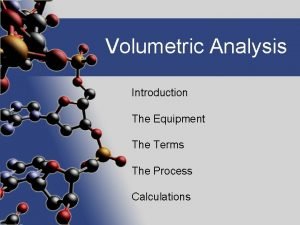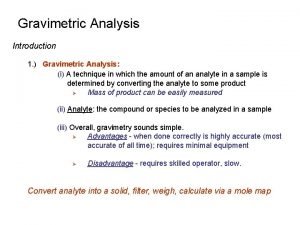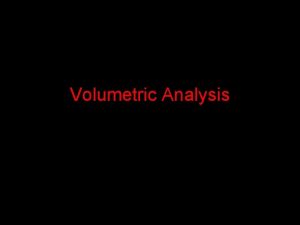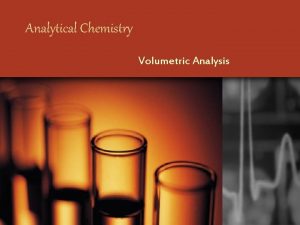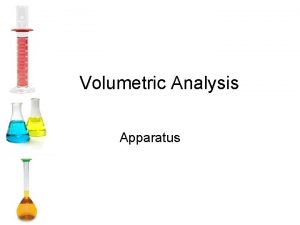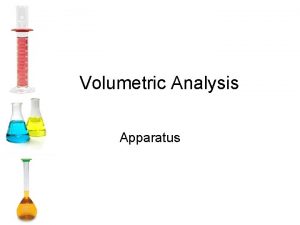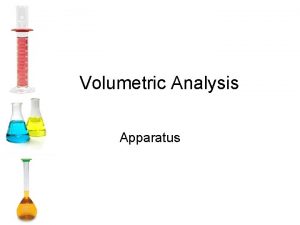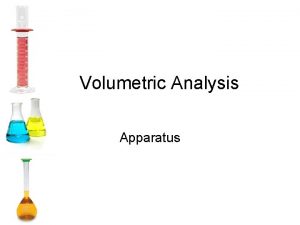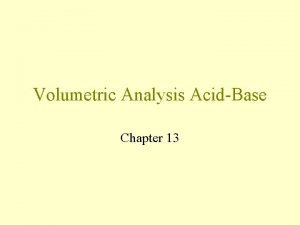Volumetric Analysis Lesson 2 Concentration Concentrations indicate the








- Slides: 8

Volumetric Analysis Lesson 2

Concentration Concentrations indicate the amount of any substance dissolved in a liquid. Square brackets, [ ], are often used as an abbreviation for the term concentration. e. g. a 0. 1 molar sodium hydroxide concentration can be referred to by [Na. OH]=0. 1 M Molarity is the most commonly used measure of concentration by chemists in the laboratory, due to it's direct relationship with chemical equations. Industry and society however do use other measures of concentrations. Percent concentration is common in calculations of drug concentration and other chemicals used in homes. Vinegar for example is 7% acetic acid. Hydrogen peroxide solutions are 3% H 2 O 2. To calculate very small concentration measures like Parts per million(ppm) are used within industry groups.

Other units of measurement % w/w is an abbreviation for percentage weight of a substance of the total weight e. g. 10 % w/w H 2 O 2 = 10 g hydrogen peroxide in 90 gm (90 ml) water. or 15 parts by weight of salt (Na. Cl) in 85 parts by weight of water (15% w/w) The formula used to calculate percent concentration is Concentration = Amount of solute 100 Amount of solvent

Percent concentration %v/v is an abbreviation for percentage volume of a substance of the total volume e. g. 12. 5 % v/v ethanol. = 12. 5 ml ethanol in approx. 87. 5 ml water % w/v is an abbreviation for percentage weight of a substance of the total volume e. g. 18% w/v orthophosporic acid (H 2 PO 4) = 18 g H 2 PO 4 in a total volume of 100 ml of solution i. e. 18 g H 2 PO 4 dissolved in water and topped up with water to the 100 ml mark in a 100 ml volumetric flask

Units of measurement Expression of concentration Examples of unit Percentage by mass (w/w) % (w/w) mass solute (g) x 100 mass of solution (g) g per 100 g Percentage by volume (v/v) % (v/v) volume solute (m. L) x 100 volume of solution (m. L) m. L per 100 m. L Percentage mass/volume (w/v) % (w/v) mass solute (g) x 100 volume of solution (m. L) g per 100 m. L

ppm The only difference in the calculations of parts per million and parts per billion is factor used to multiply the ratio. The formulas for these two are: Parts per million Concentration = Amount of solute 1, 000 Amount of solvent Note: ppm = g per million g These calculations are usually weight by weight calculations and the units of mass must be the same for both solute and solvent. To help identify the solute from the solvent , keep in mind that the solvent is the substances doing the dissolving and in any mixture is the larger portion.

Practice question Calculate the mass in grams of selenium in a body if the body weights 50 Kg and the concentration is 4. 0 ppm

Calculate the mass in grams of selenium in a body if the body weights 50 Kg and the concentration is 4. 0 ppm 1) List the given information mass of body (solvent) = 50 Kg concentration = 4. 0 ppm 2) Determine the required information Calculate the mass of selenium in grams 3) Using formula solve to mass a) Units of mass of the solute and solvent must be the same 50 Kg = 50, 000 grams b) Plug information into formula Concentration = Amount of solute 1, 000 Amount of solvent 4. 0 = Amount of solute 1, 000 50, 000 Amount of Solute (grams) = 0. 2 grams of selenium
 Concentration gradient
Concentration gradient Movement of high concentration to low concentration
Movement of high concentration to low concentration Intracellular vs extracellular ion concentrations
Intracellular vs extracellular ion concentrations Gravimetric analysis problems
Gravimetric analysis problems Types of titrations
Types of titrations Apparatus used in volumetric analysis
Apparatus used in volumetric analysis Gravimetric analysis notes
Gravimetric analysis notes Precipitation titration calculations
Precipitation titration calculations Difference between gravimetric and volumetric analysis
Difference between gravimetric and volumetric analysis
